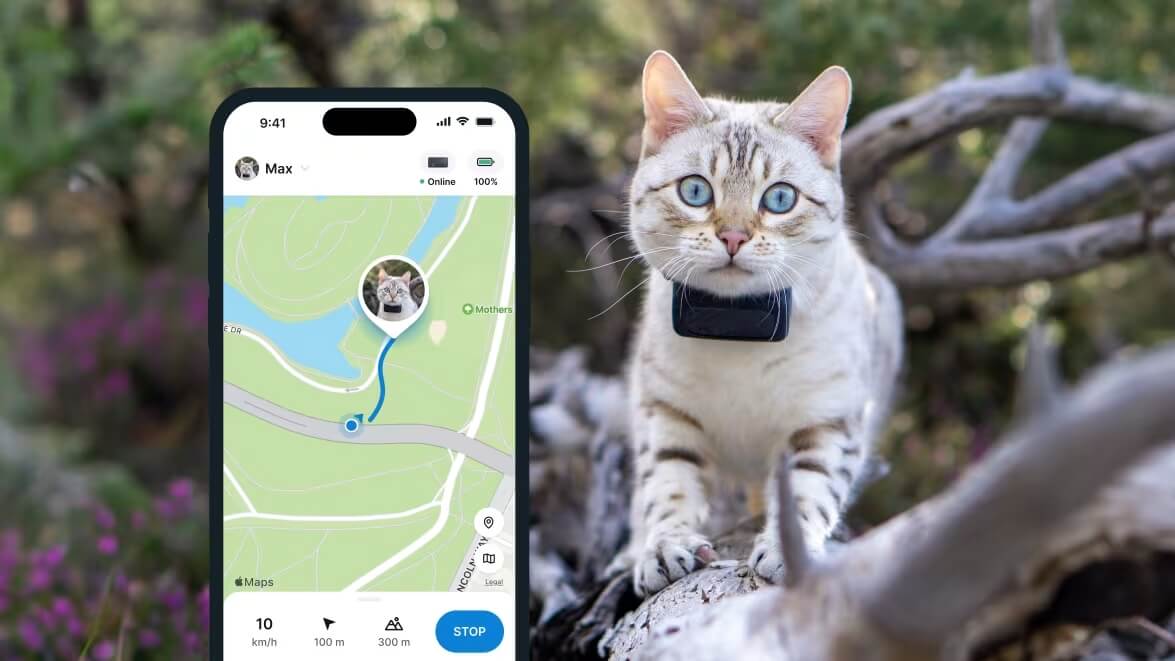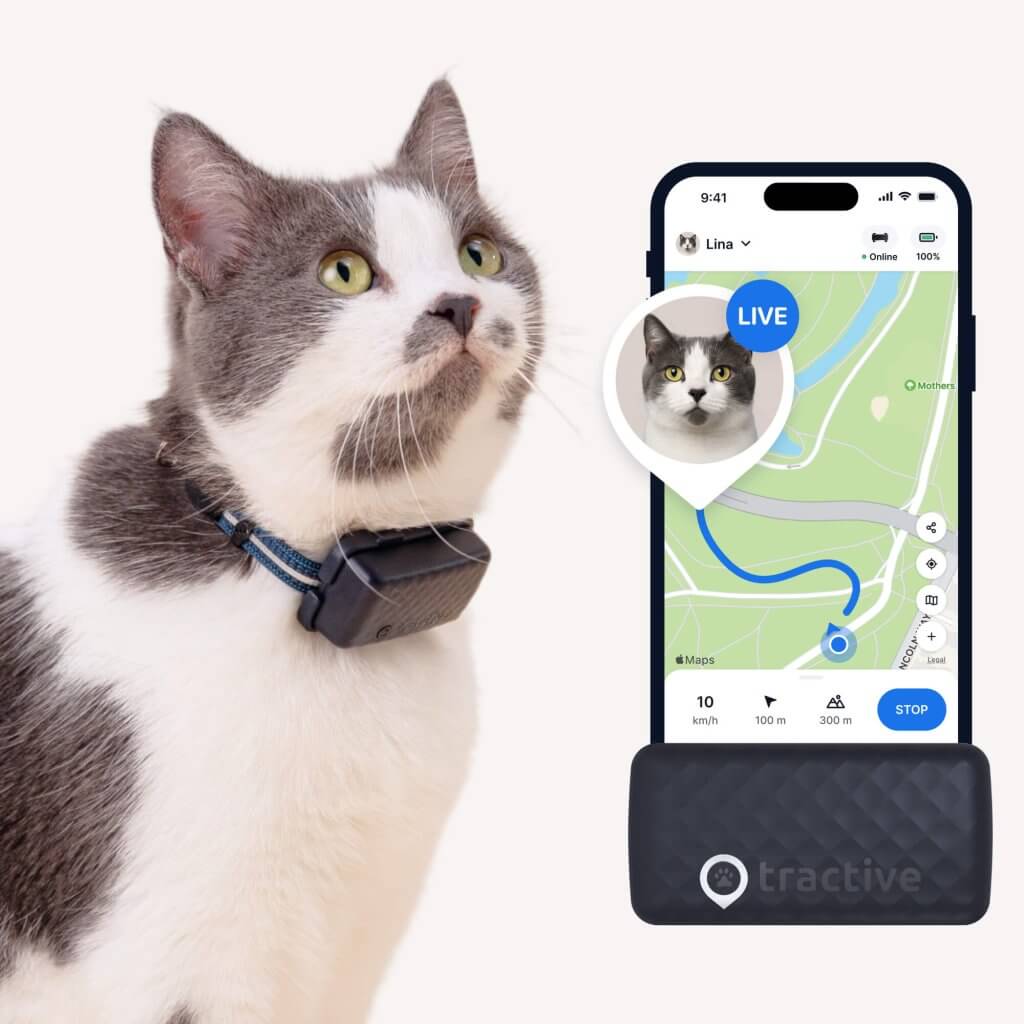How to Leash Train A Cat In Just 6 (And A Half) Steps
You might think of walks as more for dogs - but cats enjoy them just as much! So here's how to leash train a cat for a fun, safe adventure - and what steps you need to take to keep them 100% safe outdoors.
Think walking on a leash outdoors is just for dogs? Turns out, cats can and do enjoy it too! (Though only when properly trained and when you’ve taken the proper precautions.) But with all that said…how to leash train a cat? Here’s how you can offer them the safe, supervised outdoors time they need to stay happy and healthy. (Ideally, with a smart cat collar – in case they give you the slip and are now bounding away a few miles per hour.)
Key Takeaways
Leash training is beneficial for cats
It provides a safe way for indoor cats to get supervised outdoor time, which is great for their physical and mental health.
Use the right gear
Including a comfortable harness designed for cats and a lightweight, retractable leash.
Go slow and train your cat gradually
Get them used to the harness first before introducing the leash. Practice walking indoors at first and only then gradually move to familiar outdoor areas.
Use a smart cat collar as an emergency measure
Your Tractive device comes with real-time GPS tracking, Virtual Fences, and even Family Sharing to help you locate your cat if they get away.

Find out where your cat spends their time.
Read moreDoes it make sense to leash train a cat?
Absolutely. Every cat needs some outdoors time to stay happy and healthy. Much like their wild ancestors, your cat will naturally gravitate towards the outdoors, wanting to expand their territory. I.e., their little patch of land where they patrol, hunt, and show everyone else who’s boss.
With a leash attached to your cat’s harness, you can offer them the freedom to explore new areas – safely and under your supervision. It can also help keep them mentally active, as well as their senses sharp. Being in nature – i.e., outside your backyard – gives your cat the sensory stimulation they need to protect against cognitive decline as they grow older. Finally, it’s a great way to help them exercise.
So without further ado, here’s…
How to leash train your cat: Our 6-and-a-half-step guide
Let’s face it – no cat was born wearing a leash. (Or dogs, for that matter.) That’s why we’d recommend getting the green light from your vet if your cat is good to go for walking on a leash outdoors. They can help you figure out if your cat needs:
- Any anti-pest control, including treatments against fleas, ticks, and mites
- Any surgical procedures, including spaying or neutering
- Any vaccinations, if necessary
- A microchip to help someone identify your cat in case they get lost
And once you’re done, here’s step one:
1. Choose the right gear
With your cat equipped with the right gear, you’ll be that much more likely to train them successfully. So once you’ve begun scrolling online, look out for:
- A comfortable, well-fitting harness designed specifically for cats.
Some comfortable styles include H-style, vest, and figure-8 harnesses. Treat this like buying a pair of shoes – and ideally, drop by the store in person to get a good idea of their measurements. The harness should be comfortable without being restrictive; a good rule of thumb is that you should be able to fit two fingers between the harness and your cat’s body – but your cat shouldn’t be able to slip out of it either. - A lightweight, retractable leash that’s built for cats.
This can help give your cat a sense of freedom while still giving you enough control over their range of movement. Ensure the leash clip is sturdy and fastens securely to the harness. Some harnesses come with a special leash included, but make sure to shop around (with your cat’s measurements in mind) to find the best fit.
Also keep in mind that vets discourage using a leash attached to a collar alone. It’s always a good idea to fit your cat into a harness first – and walk them on a leash attached to it. This prevents them from slipping out, choking, or tangling on the leash.
2. Get your cat used to wearing a harness
Next, let’s get your cat used to wearing the harness first. You’ll eventually be attaching the leash to it, so let’s take it one step at a time.
- Introduce the harness gradually by letting your cat sniff and inspect it in a familiar environment indoors. Lay it near your cat’s favorite spots or during feeding times. (This will help them build a positive association with it.)
- Once your cat’s gotten used to the harness being around, gently place it on your cat without fastening it. Keep it on for just a few seconds at first – and reward your cat plenty (with treats and praise) once you take it off.

- Gradually extend this period from a few seconds to a few minutes. Be consistent with praise, pets, and treats.
- Once your cat doesn’t mind wearing the harness, fasten it for (very!) short periods while you’re both still indoors. Watch out for any signs of discomfort and remove the harness if your cat seems uncomfortable.
Make sure your harness fits your cat just right. You do want to avoid them wriggling out of it, after all. If they do, you likely need one in a different style or size.
Besides, always supervise your cat while they’re wearing the harness. Ideally, they shouldn’t be spending too much time wearing one indoors – rather, only when out with you on a walk.
Read more: How To Harness Train A Cat In 7 Easy Steps
3. Introduce the leash
Once your cat is comfortable wearing the harness, it’s time to introduce the leash. Be warned – your buddy might be a bit alarmed, especially given its snake-like appearance. So go slow and let them interact with the leash much like the harness earlier. Let your cat drag it around the house or bat at it – slowly getting accustomed to it over time. Supervise your cat when they’re around the leash to prevent them from getting tangled in it.
Next, watch out for some initial clawing. Your cat needs to get used to the leash as much as possible before you put it on their harness. If they’re used to playing with string, thread, wool, or even a pair of shoelaces, they might adjust a bit better.
Take some practice walks indoors at first. Hold your leash loosely and guide your cat around your house – up and down stairs and through the different rooms. Direct your cat where you want to go with a toy or a laser pointer. Be gentle when tugging at the leash to steer your cat. Make sure to reward them when they do follow your lead. Loosen it if your cat doesn’t seem to want to head a certain direction without forcing them.
Finally, never drag your cat around if they’re reluctant to move! Some days just aren’t their day – so take some time off leash training and keep them busy with some other games or playtime instead.
💡If your cat is scared of going outdoors, try sitting with them near an open door, window, or at your porch. This can help them get used to the sights and sounds of the outdoors – especially if you do it gradually, day by day.
4. Teach your cat to come back when called
Training your cat to come back when called may even save their life if you’re on a walk outdoors – and they slip out of their harness or leash after a bird or a squirrel.
- Start by standing close to your cat and calling out their name.
- At the same time, shake one of their favorite toys or a bowl full of treats.
- When your cat approaches you, praise them and offer a treat. (Or some playtime with the toy.)
- With time, this will help them realize that “coming when called = reward.”
- Gradually increase the distance as you call your cat while following the same steps.
- Rinse, repeat, and practice daily for 5-10 minutes or so.
The same method works for commands like “Sit,” or “Drop it” – all of which can prevent your cat from lunging towards any food on the sidewalk or any other forbidden “treats” you might run into while walking outdoors.
Read more: 4 Important Dog Commands & How To Teach ‘Em (all of which work on the same principle with cats!)
5. Practice walking somewhere familiar outdoors
Start in a safe, quiet, enclosed area like a backyard or patio. (Ideally, one your cat is familiar with.) This can help your cat gradually get used to this “new” form of playtime together. Keep your initial outdoor session short and gradually increase the duration as your cat grows more comfortable.
Don’t rush your cat. It’s better to let them explore these environments at their own pace. Avoid forcing them to move or venture somewhere if they seem hesitant or scared. Stay close to them to help them feel relaxed outdoors. Keep an eye out for traffic, other animals, or loud noises – all of which can make your cat spook and bolt off into the distance.
It’s also smart to let your cat walk in front of you rather than on the side. This can help you keep an eye out for anything that’s dropped on the sidewalk or path – and prevent your cat from sneaking a bite when you’re not looking.
Brought your cat in a carrier outdoors for a practice walk – but they aren’t budging from their safe spot inside? Try and encourage them with toys or treats and a bit of gentle coaxing to get them to step outside. (But of course, don’t force them. Every cat needs their own time.)
6. Gradually explore new areas
As your cat grows more familiar with nearby outdoor spaces, take them out with you progressively further away from “home.” Of course, it’s a good idea to avoid busy streets or crowded parks that might freak out your cat and trigger an escape attempt. So take it slow and only introduce your cat to new environments as they grow more confident exploring their surroundings.
Keep an eye on your cat for any signs of discomfort throughout the process. Too much stimulation from a new environment can stress them out as well.
6.5. Plan ahead for an emergency
No harness is escape-proof. Cats really are liquid and can wriggle themselves out of any tight spot in a pinch. This means there’s always a possibility, however small, that they might get loose during an outdoor adventure. And that’s where a smart cat collar with real-time GPS tracking can prevent an emergency.
Strapped to their collar, you can now:
Monitor where your cat has run off to in real-time
With LIVE tracking, you can follow your cat’s movements on a map via your Tractive mobile app. Their real-time location gets updated every couple of seconds, so you can safely intercept them right away. Besides, unlike an AirTag that needs a network of compatible devices to work, Tractive trackers work across an unlimited range. (And also 175 countries if you’re on a Premium subscription.)

Prevent your cat from running away from you
From the Tractive mobile app, you can set up a “safe zone” around a park, neighborhood, or even a designated walking path – and get an instant escape alert if your cat ventures out of it. Or set up “no go zones” for areas you’d rather they not venture near.


Get your loved ones to help in case of an emergency
Finally, with Family Sharing, you can share your cat’s location with family members or trusted friends, so everyone can help locate your pet if they go missing.

Track your cat wherever they go
Get real-time location information, wherever they go. Find out when they go somewhere they shouldn’t, with Virtual Fences. And discover their favorite spots with Territory.
And if you’ve liked this post, share it with a friend or a loved one – and let’s help build a safer, kinder world for our furry friends together. Happy walking!



